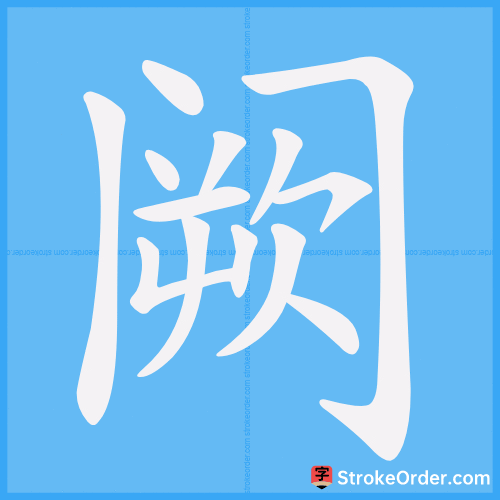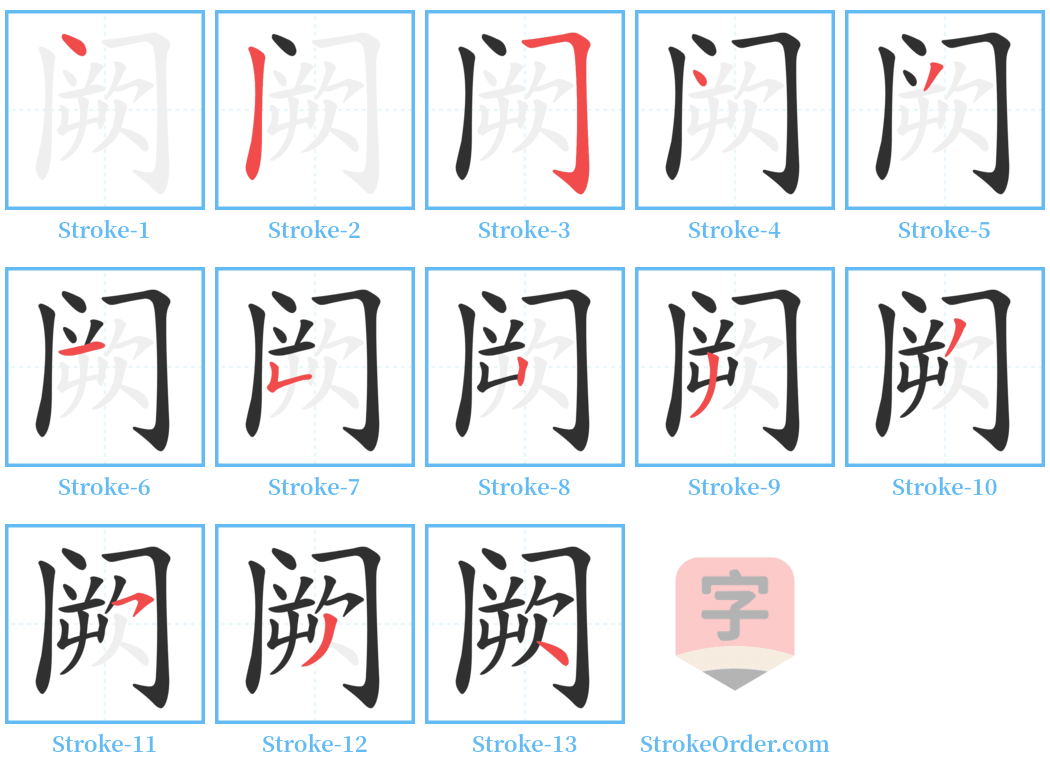阙 Stroke Order
Animated Stroke Order of 阙

Stroke Order Diagrams for 阙

Step-by-Step Handwriting Guide for 阙

Learn to Write Chinese Characters with Video Tutorials
Watch the video of writing the Chinese character "阙", learn the correct stroke order (笔顺) of the character "阙", and master the standard way of writing the character "阙".
Free Printable Handwriting Practice with Stroke Order: 阙
Printable Writing Practice Worksheet of "阙" in Portrait Orientation (Tian Zi Ge)

Printable Writing Practice Worksheet of "阙" in Landscape Orientation (Tian Zi Ge)

Information of 阙
Pinyin
què、 quē、 jué
Radical
门
Strokes
13 strokes
Usage
★★★★
Definition
deficiency, (surname) / imperial city
阙 (quē / jué)
1. In ancient times used as "缺" (quē). Meaning: vacancy.
2. Fault; error.
3. A surname.
4. A structure on either side of the palace gate for vigilance.
5. Refers to the emperor's residence; metaphorically used to indicate the court.
6. Capital city; palace.
7. Stone archways on either side of a tomb.
8. A high platform in front of ancient palaces, temples, or tombs, typically with one on each side and a path between them.
Definitions:
1. 不完整,缺少事物的状态 (Incomplete; lacking) [English: incomplete; fragmentary].
Example: 阙典 (a system of laws that is incomplete); 阙略 (incomplete).
2. 缺点或错误 (A fault; an error) [English: fault; slip; error].
Example: 阙失 (an error; a mistake); 阙政 (political measures with issues).
3. 豁口或缺口的地方 (A gap) [English: gap].
Example: 阙陷 (a depression).
4. 应补的职位或缺额 (A vacancy) [English: vacancy].
Example: 阙车 (an ancient war chariot used to fill gaps; equivalent to modern mobile reserves).
5. 代指皇宫或王权 (Used to refer to a palace or royal authority) [English: palace; court].
Example: 阙下 (beneath the palace; metaphorically referring to the court).
As a verb (动):
1. 削减或毁坏 (To cut down; to ruin) [English: cut down; ruin].
Example: 阙翦 (to damage).
2. 表示缺失或不足 (To be short of) [English: be short of].
Example: 阙少 (to lack; to be deficient).
3. 欠缺或未给 (To owe) [English: owe].
4. 通常指挖掘 (To dig) [English: dig].
As an adjective (形):
1. 不完善或残缺 (Incomplete; fragmentary) [English: incomplete; fragmentary].
Additional entries (名) include meanings related to ancient architectural elements surrounding palaces or tombs, emphasizing their societal or political significance.
Note: The character is used in various contexts including names, architectural terms, and literary references, often symbolizing the presence of a palace or authority.
Input Method for 阙
Pinyin
que4
Wubi
uubw
Cangjie
lstuo
Zhengma
tlzr
Four Corner
37482
Unicode
U+9619
Same Pronunciation Characters